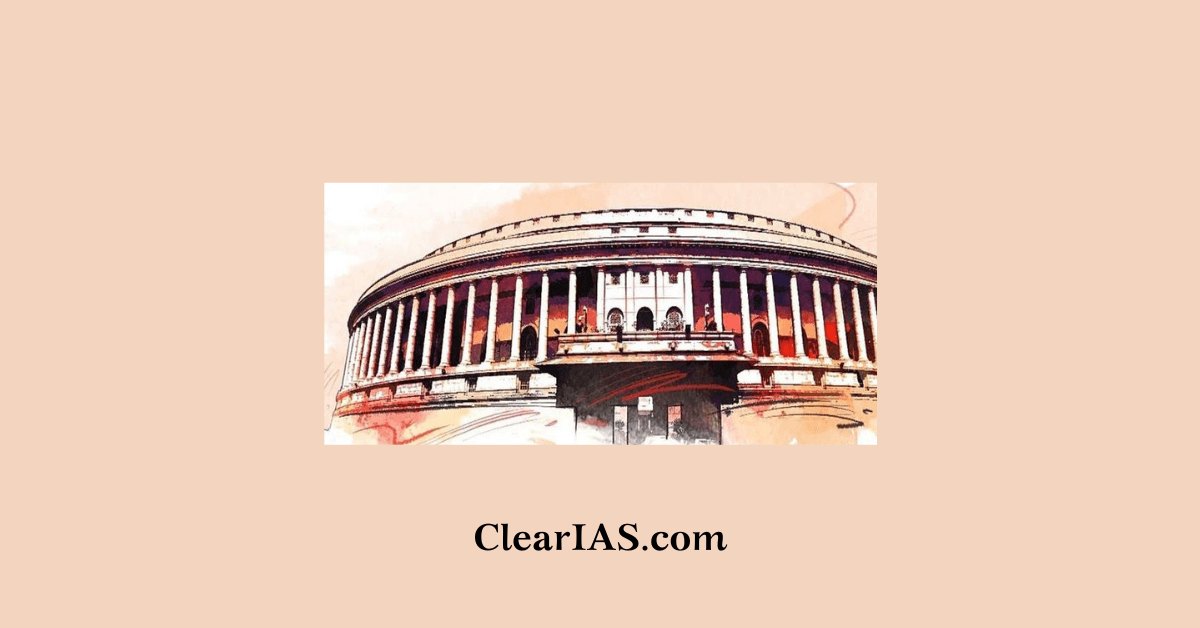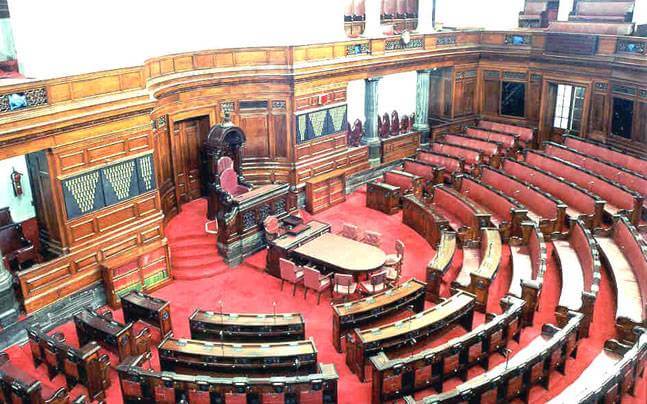
Procedures for Rajya Sabha elections are more complex when compared to Loksabha elections.
In this article, we shall discuss in detail, the procedure of elections to Rajya Sabha.
Rajya Sabha or Council of States

A single directly elected House was considered inadequate to meet the challenges before free India by the Constituent Assembly.
- A second chamber, known as the ‘Council of States’, therefore, was created with an altogether different composition and method of election from that of the directly elected House of the People.
- It was meant to be the federal chamber i.e., a House elected by the elected members of Assemblies of the States and two Union Territories in which States were not given equal representation (unlike many other federal countries).
- Apart from the elected members, provision was also made for the nomination of twelve members to the House by the President.
Also read: Sessions of Parliament: Adjournment, Prorogation, Dissolution etc.
Composition of Rajya Sabha
Article 80 of the Constitution lays down the maximum strength of the Rajya Sabha as 250, out of which 12 members are nominated by the President and 238 are representatives of the States and of the two Union Territories.
- The present strength of Rajya Sabha, however, is 245, out of which 233 are representatives of the States and Union territories of Delhi and Puducherry and 12 are nominated by the President.
- The members nominated by the President are persons having special knowledge or practical experience in respect of such matters as literature, science, art and social service.
Also read: When Does a Bill Lapse in Indian Parliament?
Allocation of Seats to Rajya Sabha
The Fourth Schedule to the Constitution provides for the allocation of seats to the States and Union Territories in Rajya Sabha. The allocation of seats is made based on the population of each State.
Consequent to the reorganization of States and formation of new States, the number of elected seats in the Rajya Sabha allotted to States and Union Territories has changed from time to time since 1952.
Name of State |
No. of Seats |
|---|---|
Andhra Pradesh |
18 |
Arunachal Pradesh |
1 |
Assam |
7 |
Bihar |
16 |
Chhattisgarh |
5 |
Goa |
1 |
Gujarat |
11 |
Haryana |
5 |
Himachal Pradesh |
3 |
Jammu & Kashmir |
4 |
Jharkhand |
6 |
Karnataka |
12 |
Kerala |
9 |
Madhya Pradesh |
11 |
Maharashtra |
19 |
Manipur |
1 |
Meghalaya |
1 |
Mizoram |
1 |
Nagaland |
1 |
National Capital Territory (Delhi) |
3 |
Nominated |
12 |
Odisha |
10 |
Pondicherry |
1 |
Punjab |
7 |
Rajasthan |
10 |
Sikkim |
1 |
Tamil Nadu |
18 |
Tripura |
1 |
Uttar Pradesh |
31 |
Uttarakhand |
3 |
West Bengal |
16 |
Process of Rajya Sabha Election
The representatives of the States and the Union Territories in the Rajya Sabha are elected by the method of indirect election.
- The representatives of each State and two Union territories are elected by the elected members of the Legislative Assembly of that State and by the members of the Electoral College for that Union Territory, as the case may be, by the system of proportional representation using the single transferable vote.
Election to Rajya Sabha: Procedure Illustrated with an Example
The Rajya Sabha seat quota for each state is fixed as per Schedule 4 of the constitution. Elections to 1/3 of these seats occur every 2 years. Let’s take an example of a state where there is a Rajya Sabha election for 3 seats.
Let there be only two parties in the legislative assembly. Party A has 100 seats and party B has 40 seats. Both parties can field three candidates each for the three Rajya Sabha seats.
To win a Rajya Sabha seat, a candidate should get the required number of votes. That number (quotient) is found out using the below formula.
Quotient = Total number of votes divided by (Number of Rajya Sabha seats + 1 ) + 1.
In the illustrated case, a candidate requires (140/4)+1, ie. 36 votes to win.
NB: Members don’t vote for each seat. If that had been the case then only the ruling party representatives would make it through. Rather, the members give preferences for each candidate (as 1, 2, 3, 4, 5 and 6).
If 36 or more members choose a candidate as their first choice, he gets elected. So Party B (the opposition party in the Loksabha assembly) with 40 seats can get one member elected if the members give preference for a candidate as first preference.
The ruling party (Party A) on the other hand can get 2 members elected (72 votes from their 100 members).






sir pls explain the “rajya saba members of Union Territory is elected by the Electoral College for that Union Territory,”. what is this electoral college consist…… is that the members of Legislative Assembly ….for that UT……? PULIMADA……(mktr)
Electoral college is create for the election of president too… It consist of.. 1- elected members of the both houses rajya Sabha and Lok Sabha
2- elected members of legislative assembly of states
3-elected members of legislative assembly of union territory
why delhi and pondicheri only have rajya saba members…………………? is it because both have Legislative Assembly …………?
Because other state don’t have that much population..
dear sir please define the meaning of electoral college in case ut election
For RS election for UT(its only for 2 UTs Delhi and Pud.)
ele.coll=elected members of legi.assembly.
In the current scenario, when BJP and NDA, can have Majority in RAJYA SHABHA?
Please exaplain in brief that example.
can a member get elected to Rajya Sabha for the fourth successive term
This post is very hhelpful
Please explain the system of proportional representation by means of the single transferable vote.
When first preferance votes are equal and one candidate have some vote of second preference how counting will be done
Nominated members of vidhansabha take part in rajya sabha election or not?
Yes
Members don’t vote for each seat.
What means
Are members of “council of states” elected on the basis of members of legislative assembly of states and ut
nice post
Pls tell the present calculation of party wise rajya sabha seats in uttar Pradesh
In the example given above if for 4th seat no one gets 44 in first preference, how are 2nd preference votes counted? Are the 2nd preference votes for all who have voted even if his 1st preference vote has been counted? If not how is it determined whose 2nd preference vote is to be counted because people may have same 1st preference but different 2nd preference.
When you choose to explain a procedure, explain it completely or don’t start at all.
You didn’t explain the transfer of votes to other preferences.
Sir/Madam
Can you please provide information regarding the provision or laws for by-election to parliament or state legislature in India.
It was really helpful for clearing my queries
Who is conducting RS elections????
Who conducts the Election is it The Election Commission
Rajya sabha election is conducted by Elections Commission of India.
why in Gujrat it is not happening ? why ECI is following other way in Gujrat for two rajya sabha seat on coming 5th july ? is this only for favouring BJP or really such procedures exists in constitution for ECI ? why Supreme court refuse to interfere in this matter ? is Supreme court also working for BJP ?
I am from thameem chennai ,if any possible without admk,dmk,i can apply for rajashaba mp election what is procedure ,i am common people
Period of by election wining candidate of rajya sabha ?
This is not Helpful. Not understand fully.
What does this mean “”The members give preferences for each candidate (as 1, 2, 3, 4, 5 and 6). If 36 or more members choose a candidate as their first choice, he gets elected””
The above illustration for a state with 3 vacancy and 140.members is wrong.It should be 140/3=46,66+1=47votes.not 36
Can a non state legislative member can contest election
Very confusing explanation.
if total number of vacant seats are 3, and one member gets all the votes in rajya sabha then Then how will the remaining two seats be filled?
If 36 or more members choose a candidate as their first choice, he gets elected. So Party B (the opposition party in the Loksabha assembly)
Shouldn’t the above be
If 36 or more members choose a candidate as their first choice, he gets elected. So Party B (the opposition party in the STATE ASSEMBLY ) instead of Lok Sabha Assembly, because it is the elected members of STATE ASSEMBLY, and not Lok Sabha Assmebly, elect members of Rajya Sabha